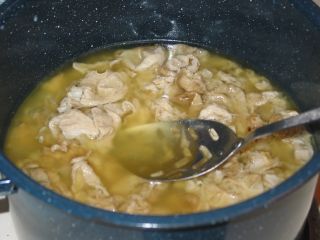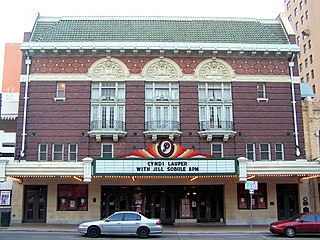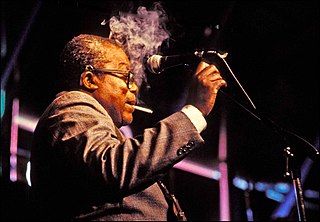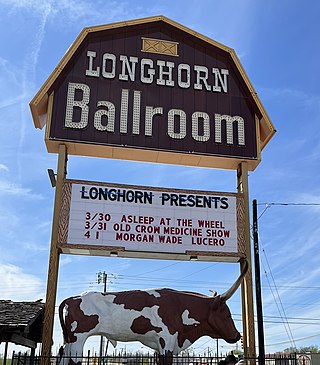
Deep Ellum is an American neighborhood composed largely of arts and entertainment venues near downtown in East Dallas, Texas. The name is based on a corruption of the area's principal thoroughfare, Elm Street. Older alternative uses include Deep Elm and Deep Elem.

Chitterlings, sometimes spelled chitlins or chittlins, are the small intestines of domestic animals. They are usually made from pigs' intestines. They may also be filled with a forcemeat to make sausage. Intestine from other animals, such as beef, lamb, and goat is also used for making chitterling.
Austin's official motto is the "Live Music Capital of the World" due to the high volume of live music venues in the city. Austin is known internationally for the South by Southwest (SXSW) and the Austin City Limits (ACL) Music Festivals which feature eclectic international line-ups. The greatest concentrations of music venues in Austin are around 6th Street, the Warehouse District, Downtown, Central East Austin, South Congress, the Red River District, the University of Texas, South Lamar, and South Austin.

Dance hall in its general meaning is a hall for dancing. From the earliest years of the twentieth century until the early 1960s, the dance hall was the popular forerunner of the discothèque or nightclub. The majority of towns and cities in the West had at least one dance hall, and almost always featured live musicians playing a range of music from strict tempo ballroom dance music to big band, swing and jazz. One of the most famous dance hall musicians was Glenn Miller.

The Fort Worth Stockyards is a historic district that is located in Fort Worth, Texas, north of the central business district. A 98-acre (40 ha) portion encompassing much of the district was listed on the National Register of Historic Places as Fort Worth Stockyards Historic District in 1976. It holds a former livestock market which operated under various owners from 1866.

The River Music Experience is a multi-use music facility and 501(c)3 non-profit organization located on the first two floors of the historic Redstone Building in downtown Davenport, Iowa.
The Chitlin' Circuit was a collection of performance venues throughout the eastern, southern, and upper Midwest areas of the United States that provided commercial and cultural acceptance for African American musicians, comedians, and other entertainers during the era of racial segregation in the United States through the 1960s.

Hyde Park is a neighborhood and historic district in Austin, Texas. Located in Central Austin, Hyde Park is defined by 38th Street to the south, 45th Street to the north, Duval Street to the east, and Guadalupe Street to the west. It is situated just north of the University of Texas and borders the neighborhoods of Hancock and North Loop.

The Crawford Grill was a renowned jazz club that operated in two locations in the Hill District of Pittsburgh, Pennsylvania. During its heyday in the 1950s and 60s, the second Crawford Grill venue hosted local and nationally-recognized acts, including jazz legends Art Blakey, Charles Mingus, Max Roach, Miles Davis, John Coltrane, Bill Evans, and Kenny Burrell. The club, an important social gathering spot for Pittsburgh's African-American communities, drew devoted listeners from the region's ethnically and racially diverse population making it a rare site of interracial socializing during the civil rights period. The Crawford Grill was one of many black-owned neighborhood clubs in the Eastern United States that supported a tour circuit for small jazz ensembles during the genre's "golden age." Despite the riots of 1968, which severely damaged the neighborhood's economic infrastructure, the club continued to operate until 2003, when it was shuttered. In 2010, a group of local investors purchased the property with the goal of restoring and reopening the location as a venue and restaurant.

The Paramount Theatre is a live theatre venue/movie theatre located in downtown Austin, Texas. The classical revival style structure was built in 1915. The building was listed in the National Register of Historic Places on June 23, 1976.

Samuel Joseph Myers was an American blues musician and songwriter. He was an accompanist on dozens of recordings by blues artists over five decades. He began his career as a drummer for Elmore James but was most famous as a blues vocalist and blues harp player. For nearly two decades he was the featured vocalist for Anson Funderburgh & the Rockets.

The Longhorn Ballroom in Dallas, Texas (USA). has been called, Texas' Most Historic Music Venue and since its inception has had a colorful set of proprietors. Originally built by O.L. Nelms, an eccentric Dallas millionaire, for his close friend, western swing bandleader Bob Wills, the venue opened in 1950 as Bob Wills' Ranch House. When Wills left In the early 50's Nelms leased the sprawling venue to notorious nightclub owner turned assassin Jack Ruby. Mr. Ruby eventually had a nervous breakdown and lost the lease, but he is credited with hosting some of the best black entertainers of the day including Count Basie, Ruth Brown, and Nat King Cole. The Nat King-Cole show took place in 1954 in the racially segregated Jim Crow South, where an affluent black audience sat in front, in the premium seats, while the white patrons stood in the back to listen to the legend.

The Fillmore Detroit is a multi-use entertainment venue operated by Live Nation. Built in 1925, the Fillmore Detroit was known for most of its history as the State Theatre. It is located near the larger Fox Theatre in the Detroit Theatre District along Woodward Avenue across from Comerica Park and Grand Circus Park. The Fillmore Detroit features a theatre with a Grand Lobby and three levels of seating, as well as the State Bar & Grill which has a separate entrance and is open when the theatre is not hosting events. The Detroit Music Awards are held annually at The Fillmore Detroit in April. The building was listed on the National Register of Historic Places in 1982.

The Plaza Super Cinema and Variety Theatre cinema in Stockport, England opened in 1932 and is now a Grade II* listed building. After being a bingo hall for many years, it has now been restored as a cinema and theatre, showing classic films and staging live shows.

The Uptown Theater in Philadelphia, Pennsylvania, also known as Uptown Theater and Office Building, is an Art Deco building built in 1927. It was designed by the Philadelphia-based architectural firm of Magaziner, Eberhard & Harris. The Uptown Theater is located on 2240 N. Broad Street. It became a major venue on the Chitlin' Circuit, from 1951–1978. It was listed on the National Register of Historic Places in 1982.
The National Rhythm & Blues Hall of Fame is an independent organization whose mission is to educate and to celebrate, preserve, promote, and present rhythm and blues music globally.

The Dew Drop Inn, at 2836 LaSalle Street, in the Faubourg Delassize section of Central City neighborhood of New Orleans, Louisiana, is a former hotel and nightclub that operated between 1939 and 1970, and is noted as "the most important and influential club" in the development of rhythm and blues music in the city in the post-war period. The venue primarily served the African-American population in the then heavily segregated Southern United States.

Denver Darious Ferguson was an American businessman and nightclub owner in Indianapolis, who had a leading role in establishing the "Chitlin' Circuit" of entertainment venues for black entertainers and audiences in the 1930s and 1940s. Earlier in his career he established a newspaper The Edmonson County Star, in his home town of Brownsville, Kentucky, before moving to Indianapolis where he had a printing company. His younger brother Sea Ferguson helped in the print shop and with his other business ventures. After leaving the publishing business, Denver Ferguson became successful in illegal gambling and invested in property as well as a talent management and promotion business. Musician and record producer Sax Kari described him as "the man who invented the chitlin’ circuit".
Andrew "Sunbeam" Mitchell (1906-1989) was a Memphis-based businessman. He owned various establishments on the Chitlin' Circuit. Mitchell ran nightclubs for 40 years until selling off his holdings in the 1980s.
1619 West Poplar is a historic performance venue in San Antonio, Texas. From 1950 to 1964 it was Don Albert and Willie "Red" Winner's Keyhole Club. Albert helped manage and hosted musical acts. It was adorned with neon lights and signage. The building now hosts the Sociedad Fraternal Cruz Blanca and is used for weddings and wrestling events.















